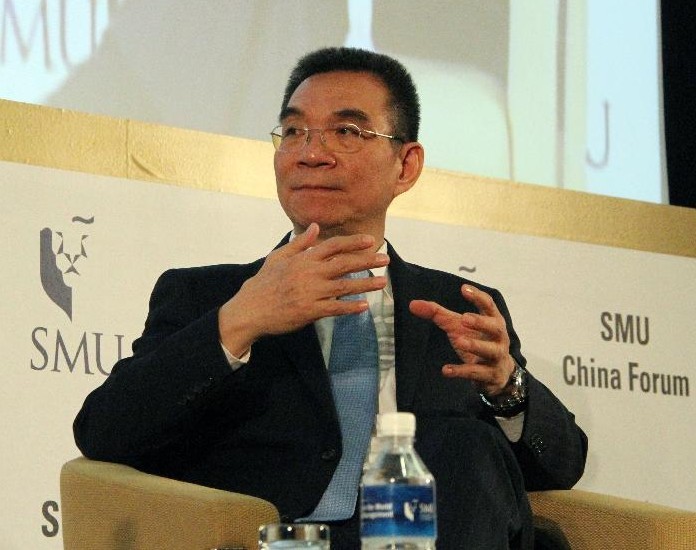

Justin Yifu Lin, former senior vice president and chief economist of the World Bank, shares his views on China's growth paths and the outlook for the Chinese economy at the inaugural Singapore Management University China Forum in Singapore, Nov. 13, 2013. China is at a development stage where it is necessary to remove the distortions and bottlenecks in the mechanism for resources allocation, Lin said on Wednesday. (Xinhua/Chen Jipeng)
China is at a development stage where it is necessary to remove the distortions and bottlenecks in the mechanism for resources allocation, former World Bank chief economist Justin Yifu Lin said on Wednesday.
"It's time to remove these kinds of distortions and the Chinese leadership certainly understand this issue very well," he told the inaugural Singapore Management University China Forum.
Lin, who is currently the honorary dean and professor at the National School of Development of Peking University, also said China is "ready" to pursue reforms to allow the market to play a fundamental role in the allocation of resources in its economy.
The reason is that China is already at a development stage where it is no longer short of capital and, instead, has an advantage in capital-intensive industries such as automobile and equipment manufacturing, he said.
China was successful in gradually moving from planned economy to a market economy, but it has also adopted a dual-track approach over the years, allowing China to "cross the river by groping for the stones."
Lin said this allowed China to sidestep the trap where nearly all the economic sectors collapse when all the distortions are removed simultaneously and all of a sudden.
As for the fundamental drivers of growth, Lin highlighted constant technological innovation and industrial upgrading for any economy. China was able to utilize its advantage of backwardness, he said.
The world's largest developing economy started with labor intensive industries where it had a comparative advantage after it opened up to foreign investment.
But now it is already at a stage where it is starting to have an advantage in the capital-intensive sectors, Lin said.
It means that the distortion in resources allocation mechanism that has the households and the small firms effectively subsidizing the operations of the big firms seems increasingly absurd and even causes social concerns.
Lin said that the distortions and bottlenecks are a legacy from the era of planned economy. The big firms, many of them state- owned, have access to cheap credit, whereas it is difficult for the small firms and the household to get access to the credit.
China has already scrapped the cap on lending rates and the next step would be to remove the limit on savings rates, thereby achieving an interest rate determined by the market, he said.
China needs more smaller financial institutions that operate in the provincial or local markets, Lin said.
Meanwhile, Lin said that he remains confident of China's growth for the coming years.
China's per capita income in 2008 was around 21 percent of the U.S. per capita GDP. This is like Japan in 1951, Singapore in 1967 and South Korea in 1977, and these East Asian economies managed to achieve an average annual growth rates between 7.6 percent and 9.2 percent in the 20 years after that.
It is therefore still possible for China to have another 20 years of sustained high growth of around 8 percent per year from 2008, Lin said.
Certainly China has to continue to carry out structural reforms in order to achieve what is theoretically possible, he added.
Lin said the Chinese leadership is trying to push reforms for the market to play a larger role in the allocation of resources.
The senior economist also said that it is important for China to continue having high savings rate and having investment as a key driver of the economy.
All the economies that achieved sustained high growth had had very high savings rates.
Lin said it was not surprising given that both technological innovation and industrial upgrading, the key drivers of growth, require investment.
"Certainly, for investment to contribute to economic growth, it has to be effective ... to make investment in areas which can improve productivity. But that does not mean we don't need to do investment," he said.
Copyright ©1999-2018
Chinanews.com. All rights reserved.
Reproduction in whole or in part without permission is prohibited.